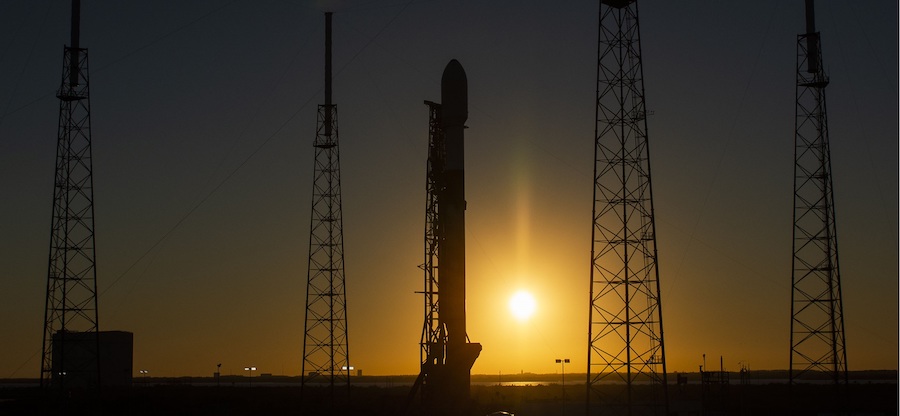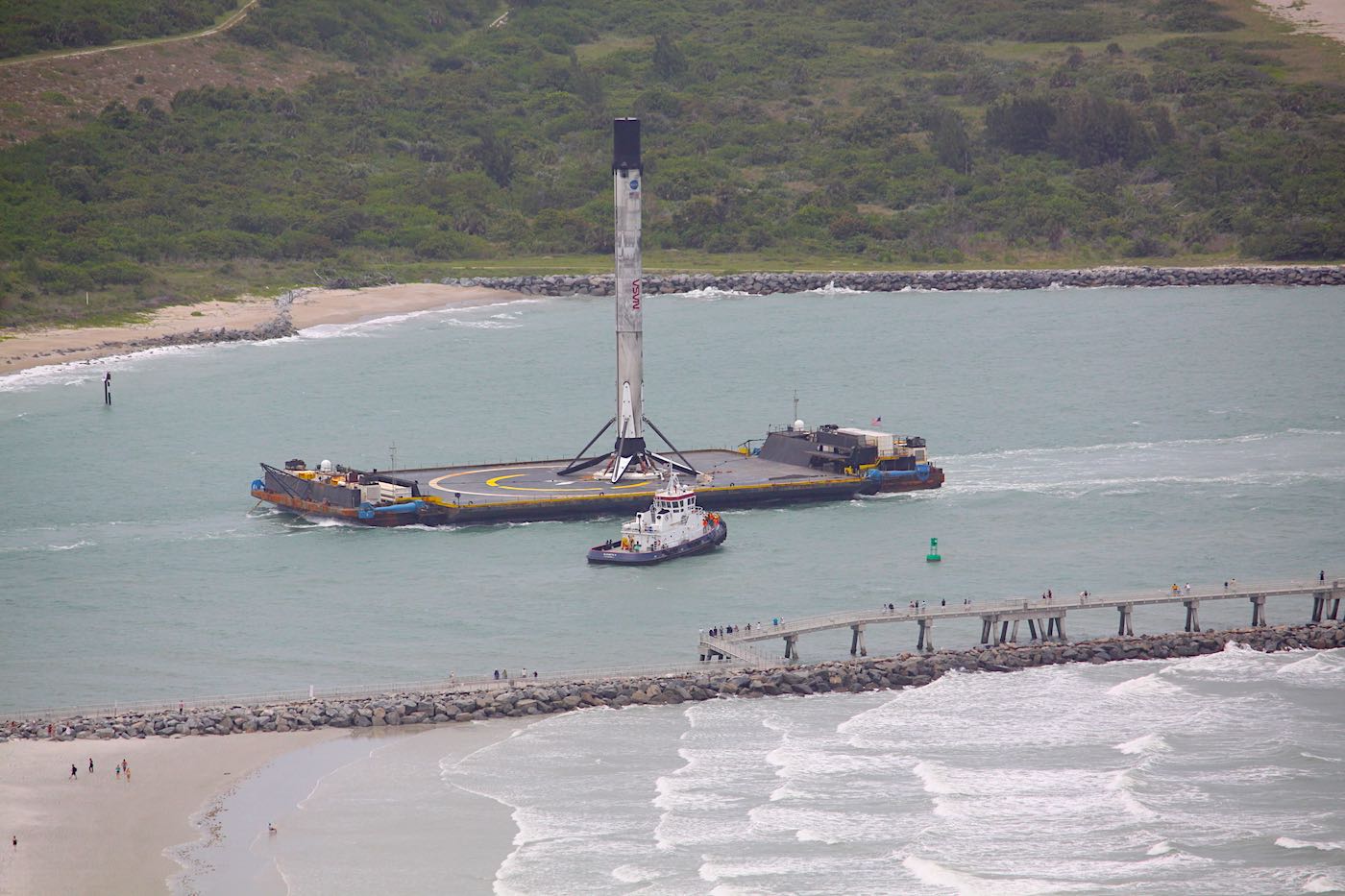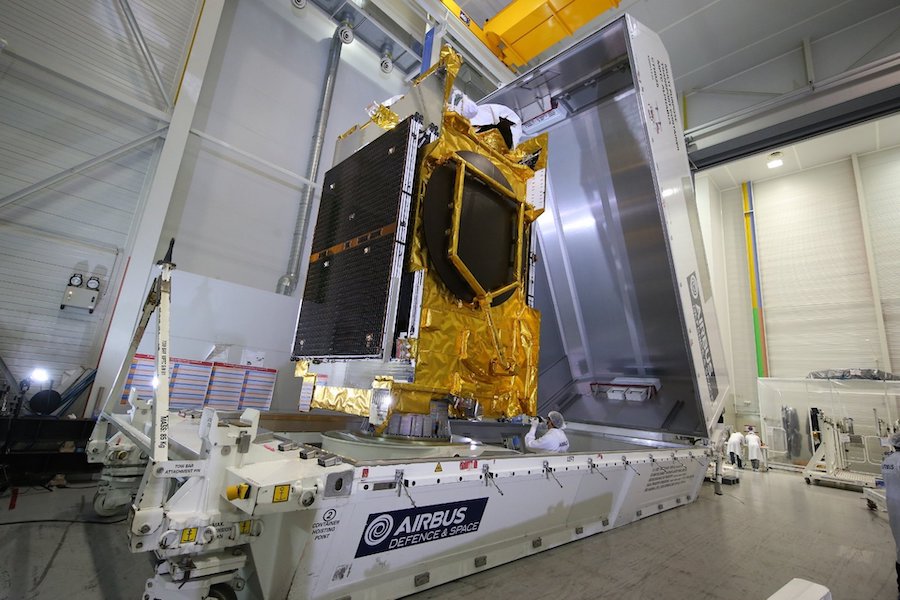
SpaceX aims to re-launch the Falcon 9 booster Monday that catapulted astronauts Doug Hurley and Bob Behnken toward the International Space Station in May, this time carrying a South Korean military communications satellite while pursuing a record for the quickest turnaround time between flights of an orbital-class rocket stage.
In a tweet Saturday, the California-based launch company confirmed plans to launch the South Korean Anasis 2 military communications satellite Monday from pad 40 at Cape Canaveral Air Force Station. The mission was previously scheduled to launch Tuesday, July 14, but SpaceX delayed the launch to address a problem on the Falcon 9’s second stage.
The launch window Monday opens at 5 p.m. EDT (2100 GMT) and runs until 8:55 p.m. EDT (0055 GMT). The official launch weather forecast calls for isolated rain showers at Cape Canaveral on Monday evening, but there’s a 70 percent chance of acceptable conditions for liftoff of the Falcon 9 rocket during the nearly four-hour launch window.
If the Falcon 9 rocket can take off with the Anasis 2 satellite Monday, or some time later this month, SpaceX will break its own record for the shortest turnaround between flights of the same Falcon 9 booster. The shortest span between launches of the same Falcon 9 booster to date has been 62 days, which SpaceX achieved with a Feb. 17 mission.
NASA achieved a 54-day turnaround time between two launches of the space shuttle Atlantis in late 1985, a record never again matched during the 30-year-long shuttle program. The time elapsed between Atlantis’s landing and next launch was 50 days.
Once the Anasis 2 mission is off the ground, SpaceX may eclipse its rocket turnaround time record again in the coming weeks.
Utilizing pad 40 at Cape Canaveral Air Force Station and pad 39A at the nearby Kennedy Space Center, SpaceX has five missions on its launch schedule from Florida’s Space Coast in the next month or so, beginning with the launch of Anasis 2 Monday.
SpaceX’s next launch of satellites for its Starlink broadband network is expected to launch some time in late July, although a firm launch date has not been confirmed by SpaceX. That mission was supposed to launch in late June from pad 39A at the Kennedy Space Center, but SpaceX has called off two launch attempts due to unspecified technical issues with the rocket.
Two commercial Earth-imaging microsatellites from BlackSky are hitching a ride to space on the Falcon 9 rocket with 57 of SpaceX’s own Starlink platforms. An official from Spaceflight, the rideshare launch broker that secured the ride for the BlackSky satellites on the Falcon 9, said Wednesday that the mission was then expected to take off toward the end of July.

Argentina’s SAOCOM 1B radar observation satellite was previously scheduled for liftoff as soon as July 25 on a Falcon 9 rocket, and another batch of Starlink satellites — flying in tandem with three Earth-observing satellites from Planet — was expected to launch around the end of July.
Those launches are expected to be delayed as a result of the schedule slips encountered by the previous Anasis 2 and Starlink/BlackSky missions. Another Starlink launch on a Falcon 9 is also planned is also planned later in August from Cape Canaveral.
Schedules for subsequent Starlink missions have not been announced, but SpaceX is booked to launch the next Crew Dragon spacecraft with astronauts to the International Space Station and a GPS navigation satellite as soon as September.
SpaceX currently has five Falcon 9 boosters in its inventory, and the company has flown two brand new first stages in its 11 missions so far this year. At least two more new Falcon 9 first stages are scheduled to enter service in the coming months, with SpaceX’s next launch of astronauts and the next launch of a U.S. military GPS navigation satellite, both currently planned no earlier than September.
A Falcon Heavy launch planned in late 2020 with a clandestine U.S. military payload will fly with three Falcon rocket boosters, all brand new. SpaceX officials said in December that the company planned to build around 10 new Falcon first stages in 2020.
With its success in reusing Falcon 9 booster stages, the company has ramped up production of Falcon 9 second stages, which are new on each mission.
Elon Musk, SpaceX’s founder and CEO, has previously said he wants to launch, recover and re-launch Falcon 9 booster twice within a 24-hour period. But Musk has not recently repeated those comments, instead focusing on SpaceX’s larger, next-generation Starship launch vehicle to make the next leap in reusable rocket technology.
The Falcon 9 booster assigned to the Anasis 2 mission is designated B1058. The launch Monday will mark SpaceX’s 12th mission of the year, and the second to use the B1058 vehicle.
During its launch with astronauts May 30, the 156-foot-tall first stage detached from the Falcon 9’s upper stage and the Crew Dragon spacecraft around two-and-a-half minutes after liftoff. While the Crew Dragon accelerated into orbit, the booster fired engines in a series of maneuvers to land vertically on SpaceX’s drone ship parked in the Atlantic Ocean less than 10 minutes into the mission.
The drone ship returned to Florida’s Space Coast with the booster on its deck June 2, and SpaceX took the rocket back to a refurbishment facility at Cape Canaveral for inspections and preparations for its next mission.
SpaceX plans to recover the booster again after Monday’s launch.
The company’s drone ship “Just Read The Instructions” is in position around 400 miles (645 kilometers) east of Cape Canaveral, and two vessels have been dispatched into the Atlantic Ocean to retrieve the Falcon 9’s two-piece payload fairing.

The Anasis 2 spacecraft awaiting launch Monday was manufactured by Airbus Defense and Space in Toulouse, France, and transported to Cape Canaveral last month on an Antonov An-124 cargo plane. Based on Airbus’s Eurostar E3000 satellite design, Anasis 2 “will provide secured communications over wide coverage,” Airbus said in a statement.
The spacecraft will launch into an elliptical, egg-shaped transfer orbit stretching tens of thousands of miles above Earth. The satellite’s on-board propulsion system will circularize its orbit at an altitude of more than 22,000 miles (nearly 36,000 kilometers) over the equator to reach a geostationary position, where Anasis 2 will remain over a fixed geographic location, circling the planet at the same rate as Earth’s rotation.
South Korea purchased the satellite — formerly known as KMilSatCom 1 — through an arrangement to offset South Korea’s purchase of F-35A fighter jets from Lockheed Martin. Lockheed Martin ultimately subcontracted the satellite manufacturing deal to Airbus.
Before Anasis 2, South Korea’s military has relied on international and civilian-owned satellites for communications.
Further details about the Anasis 2 satellite are shrouded in secrecy at the wishes of the the spacecraft’s owner — the South Korean government.
Citing a request from its customer, SpaceX said Saturday that its launch webcast for the Anasis 2 launch will end after landing of the Falcon 9’s first stage booster, expected around eight-and-a-half minutes after liftoff. At that time, Anasis 2 and the Falcon 9’s upper stage should be in a low-altitude parking orbit, coasting until restart of the second stage’s Merlin engine at T+plus 26 minutes, 32 seconds.
After a 56-second second stage burn to send Anasis 2 into a higher orbit, the spacecraft will separate from the Falcon 9 rocket at T+plus 32 minutes, 29 seconds.
Email the author.
Follow Stephen Clark on Twitter: @StephenClark1.



